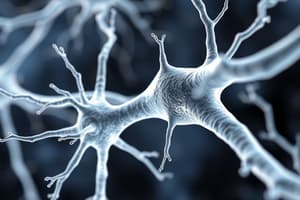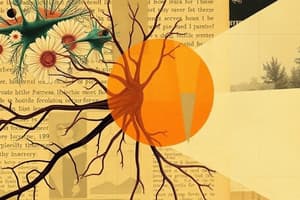Podcast
Questions and Answers
Which property of a neuron helps to ensure that action potentials propagate over long distances?
Which property of a neuron helps to ensure that action potentials propagate over long distances?
- High membrane resistance (correct)
- Low internal resistance
- High capacitance
- Short length constant
What is the primary role of myelin in the conduction of action potentials?
What is the primary role of myelin in the conduction of action potentials?
- To insulate the axon and facilitate saltatory conduction (correct)
- To slow down the conduction speed
- To increase the capacitance of the axon
- To generate action potentials at the nodes
What is the function of glial cells in the context of action potential propagation?
What is the function of glial cells in the context of action potential propagation?
- To directly transmit impulses between neurons
- To increase the internal resistance of the neuron
- To generate action potentials in neurons
- To provide structural support and insulation (correct)
How does saltatory conduction enhance the speed of action potential propagation?
How does saltatory conduction enhance the speed of action potential propagation?
What initiates the propagation of an action potential along an excitable membrane?
What initiates the propagation of an action potential along an excitable membrane?
What prevents an action potential from propagating backwards along an axon?
What prevents an action potential from propagating backwards along an axon?
What type of synapse allows ions to freely pass between adjacent neurons?
What type of synapse allows ions to freely pass between adjacent neurons?
What is the main characteristic of chemical synapses?
What is the main characteristic of chemical synapses?
What is the primary trigger for the release of neurotransmitters from vesicles in axon terminals?
What is the primary trigger for the release of neurotransmitters from vesicles in axon terminals?
What is the role of the postsynaptic membrane in a chemical synapse?
What is the role of the postsynaptic membrane in a chemical synapse?
What is the role of voltage-gated Na+ channels in excitable cells?
What is the role of voltage-gated Na+ channels in excitable cells?
Which type of cell is capable of conducting action potentials over long distances?
Which type of cell is capable of conducting action potentials over long distances?
As signals travel along a neuron, what is the function of the myelin sheath?
As signals travel along a neuron, what is the function of the myelin sheath?
What is the primary advantage of saltatory conduction?
What is the primary advantage of saltatory conduction?
Which component of the neuron is responsible for integrating input signals?
Which component of the neuron is responsible for integrating input signals?
What is the synapse responsible for in neuronal communication?
What is the synapse responsible for in neuronal communication?
Which of the following statements about glial cells is true?
Which of the following statements about glial cells is true?
In a neuron, the initial segment of the axon is crucial for what process?
In a neuron, the initial segment of the axon is crucial for what process?
What do excitable cells lack that prevents them from generating action potentials?
What do excitable cells lack that prevents them from generating action potentials?
When a voltage is applied across a membrane in a biological tissue, what type of current is initially generated?
When a voltage is applied across a membrane in a biological tissue, what type of current is initially generated?
Flashcards are hidden until you start studying
Study Notes
Impulse Conduction
- Action potentials (APs) are initiated when Na+ influx reverses the membrane potential from negative to positive.
- The local reversal generates a depolarizing current that propagates to adjacent membranes.
- Once initiated, APs propagate along the axon without diminishing.
Excitable Cells
- Excitable cells, such as neurons and muscle cells, possess voltage-gated Na+ channels essential for AP generation.
- Non-excitable cells can conduct passive currents but lack the capacity to generate APs.
- Neurons have long axons, which act as conduits for transmitting APs over distances.
Structure of a Neuron
- Neurons consist of several key components:
- Cell body (nucleus)
- Dendrites (input region)
- Axon (transmission region) split into axon hillock and initial segment.
- Myelin sheath (insulator to speed up conduction)
- Postsynaptic neuron (target cell receiving signals).
Functional Dynamics of Action Potentials
- APs cannot reverse direction due to the refractory period, rendering Na+ channels inactivated after depolarization.
- APs propagate in one direction towards synaptic terminals where they signal the release of neurotransmitters.
Synapses
- Synapses form the functional association of neurons with other neurons or effector organs (muscles or glands).
- Two main types of synapses exist: electrical and chemical.
Electrical Synapses
- Electrotonic synapses (gap junctions) feature membranes approximately 35Å apart.
- Connexins connect adjacent cells, facilitating the passage of small ions and depolarization waves.
Chemical Synapses
- Neurotransmitter release occurs in the synaptic cleft, a specialized space about 200 Å wide.
- Presynaptic terminals (boutons) contain vesicles with neurotransmitters, while postsynaptic membranes have receptors for these transmitters.
- The cleft is crucial for neurotransmission efficiency and specificity.
Axon Terminal and Vesicle Release
- Axons conclude in boutons loaded with vesicles containing neurotransmitters, which are released upon appropriate stimulation.
- Exocytosis of vesicles is triggered by the influx of Ca++ ions.
Studying That Suits You
Use AI to generate personalized quizzes and flashcards to suit your learning preferences.



